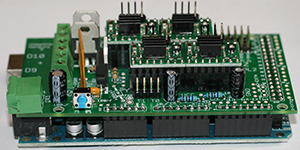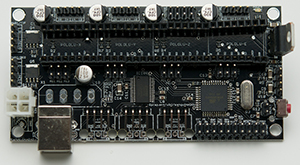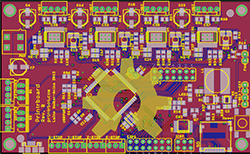
If you’re gearing up to build a 3D printer, one of the first things you’ll need to look at is your options for electronics boards. Whether you decide to optimize for cost or capability, the choices you make during the planning stages of your build will drastically affect what the final project will look like and how it will behave.
There are a ton of electronics boards out there, so for this installation of 3D Printering, we’re going to take a look at what’s available. Hit the link below to give Hackaday more pageviews read the rest.
 RAMPS, RUMBA, and RAMBo
RAMPS, RUMBA, and RAMBo
RAMPS, the RepRap Arduino Mega Pololu Shield, is the OG RepRap electronics board. The board itself is fairly basic – a few sockets for Pololu stepper motor drivers, a few MOSFETs for heaters and fans, and a few screw terminals to connect a power supply.
Since this is a shield, all the intelligence for this board comes via an Arduino Mega. While the stock setup is quite minimal compared to other electronics boards, RAMPS can be extended with an SD card add-on or a control panel that allows you to operate your 3D printer sans computer
RAMBo is a derivative of RAMPS, the key difference being everything – including the microcontroller – is on one board. This has the advantage of being a simpler solution, but there’s also the problem of having soldered-on stepper drivers. If those chips burn out… well, you better be good with a solder wick.
RUMBA gets away from the problem of integrated stepper drivers, but still keeps with the ‘everything on one board’ ideology of RAMBo. Like RAMBo, it features five motor drivers for X, Y, Z, and two extruders and can handle SD cards and a control panel.
The Sanguinololu and derivatives
This barely-pronounceable board does away with the Arduino Mega + Shield paradigm of RAMPS by putting everything on a single board. Based on the Sanguino, an ATMega644P based Arduino clone, the Sanguinololu is a little underpowered in terms of Flash memory and RAM compared to the Arduino Mega + RAMPS combo, but the current 1.3b revision of the Sanguinololu with an ATMega1284P gives it enough space to run just about any firmware you could need.
As with RAMPS and most other electronics, the Sanguinololu uses Pololu stepper motor drivers that are easily replaceable in the event of one burning out. Despite the rather limited microcontroller, a Sanguinololu with an ATMega1284P is able to make use of an SD card adapter and an LCD control panel.
The popularity of the Sanguinololu has spawned a few derivatives. One of these is the Teensylu, based on an Atmel AT90USB1286 chip to get rid of the FTDI serial chip found on the Sanguinololu. Other than that, the two boards are relatively comparable.

As all things in open hardware, there’s always a better solution. When the Printrbot team was looking for an electronics board for their outrageously popular printer, they turned to the Teensylu as the inspiration for their Printrboard.
Like the Teensylu, the Printrboard doesn’t need an FTDI chip thanks to its AT90USB1286 microcontroller, It also includes an integrated SD card slot unlike the Teensylu and can work with the Panelolu control panel. Despite what a few people say about the Printrbot, the Printrboard is a really nice piece of kit, with the only (possibly imaginary) downside being the soldered-on stepper drivers.
How about a DIY solution?
The RepRap project was initially created to design a self-replicating machine. Due to fears of a gray goo scenario and the economic realities of selling a truly ubiquitous device in a post-scarcity society on Kickstarter, this idea has slowly faded away. Great strides have been made in electronics that are able to be fabricated at home on cartesian-bot platforms, though, the latest advancement being [Traumflug]’s Gen 7 electronics board
The Gen 7 board is the ultimate in DIY electronics boards. In terms of capabilities, it’s pretty close to the Sanguinololu – not the best, but more than capable of driving a 3D printer. This board truly is a work of art, and if someone at your hackerspace is really good with fabbing PCBs, you might want to ask them to do a workshop featuring the Gen 7 electronics.
 Other Boards
Other Boards
The above boards use AVR microcontrollers. While they work for what they’re intended to do, there are a few limitations. Arcs and circles are a little weird to program, and using these boards for something other than a cartesian 3D printer – a CNC machine, or a laser cutter, for example – is a bit out of the ordinary. The Smoothie board is the solution to these problems.
The Smoothie is powered by an ARM Cortex M3, giving it a lot more computational power than even the fairly powerful boards above. This is a boon for non-traditional 3D printers such as SCARA arms, Delta bot printers, and an H-bot printer we’ve seen before.
If that’s not enough, the Smoothie also has freakin’ Ethernet. There’s a control panel in the works as well, but finding a supplier is a bit more trouble than it should be.
The Takeaway
All of these boards have their plusses and minuses, but despite a lot of variation, they’re all fairly comparable and cost about the same. The major firmwares have been ported to most of these boards, and extended capabilities, such as an SD card slot and a control board, are available on just about all of them.
I’m not in any position to tell you which board is the best, but I will say I’ll probably be retiring the Sanguinololu on my Mendel for a Printrboard for my upcoming Prusa i3 build (if someone can find me a US supplier for the aluminum plates…) Take that for what it’s worth if you’re planning your first 3D printer build.
If you’re looking for an electronics board for a fairly complex printer, you might want to consider a RAMPS or RAMBo board. That has dual extruder drivers, should you ever want to experiment with multicolor or multimaterial prints. That, and it’s more or less the de facto standard among homebuilt 3D printers.
















Hi,
you missed something you can use the RUMBA with a single driver for two Z motors as well, so you would even be able to build a three extruder machine ;)
Best Regards
yeah, i was about to say: RUMBA has a total of six motor control board slots and dual outputs for each (pins AND screw in terminals), five thermistor ports, 5 PWM capable power outputs (for fans/hotends) and a dedicated heated bed power output (which can run off a separate power rail than the rest)
having used RAMPS 1.4. RAMBO and now RUMBA; the RUMBA is my new fave!
What are people’s experience with stepper drivers burning out? What causes them to fail?
Most stepper driver chips have built in thermo fuse circuity. If the housing of the chip is however very small, it seems like the temperature fuse newer gets a chance to react. By adding thermal mass (like RAM coolers or other similar) you a generally able to eliminate any frying of chips. Using the bigger housed chips (which is standard on some designs, like the printrboard designs), is another way to add thermal mass.
Another reason for frying chips can be connecting/disconnecting steppers while the stepper driver is engaged. They don’t always fry, but its a high risk action.
Imagine that your stepper motor driver is someone bouncing on a trampoline up, and down, and up, and down. Then some joker comes along and pulls the trampoline out from under the person while they’re up in the air. What happens to that person when they hit the ground? It’s a high risk action. :)
Anecdotally I have heard that disconnecting or connecting a stepper motor while the board is powered and/or stepper motor is enabled can cause chip failure. Along the same lines, flaky motor connections are also reported to cause the same problem. I have never had this experience myself though so I’m only reporting what others have had to say on the matter.
After building my 4th Printer with [Traumflug]‘s Gen 7 electronics I can really recommend it to all DIY-Guys :) Using Repetier Host and Firmware I’m getting satisfying results.
Hi, recently you publish http://hackaday.com/2013/07/28/grbl-compatible-arduino-cnc-shield/. That seem to me better options. Coud some one compare features of this and that solutions?
I liked http://blog.amberspyglass.co.uk/2013/07/22/buildlog-net-stepper-shield-back-in-stock/ and http://blog.protoneer.co.nz/arduino-cnc-shield/
Best regads, Pescadito
> The RepRap project was initially created to design a self-replicating machine. Due to fears of a gray goo scenario and the economic realities of selling a truly ubiquitous device in a post-scarcity society on Kickstarter, this idea has slowly faded away.
I’d like to hear more about this. Is this for real? Should I stop saving up for a RepRap?
Rule Number 1: Never, ever take me seriously.
In the Reprap project’s very early days, the most frustrating thing for anyone interested in building a printer was that it was nigh-impossible to get the printed parts. There were very few printers that could produce them, it took a very long time, and was very error prone. Because of this, they were super expensive. After a bit of that, people started toying with the idea of making a printer that didn’t have self-replication as one of its core values. While I typically think of Makerbot as starting out trying to produce Repstraps (bootstrapping reprap printers), they provided an early, proven model that people were much more interested in having a printer than in having a printer that could print a printer. Multiply that by a couple dozen printer designs, and suddenly people aren’t so interested in a self-replicating printer – especially if the choice is 1) get a printer now that can’t self-replicate or 2) wait for a printer that can self-replicate.
The Reprap project is still alive and well – and its core values still contain a self-replicating printer. However more and more printer designs coming out of the community are focused on other things. It’s not that the idea of reprap is dying, it’s just that fewer people are concerned with it.
While laudable goal, we are nowhere near printing pc boards and stepper motors, so self replicating is a bit of a stretch. Plastic parts are also just plane not suitable for building some things. If you scale up, more and more of a 3d printer has to be metal, particularly if accuracy matters. But, there are metal printers now if you are serious :-)
I want a board that sits on top the beagle bone black, to retire my raspberry pi + sanguinolou setup. However they are pretty pricey for what seems to be fairly cheap BOMs
What about the pic based Linistepper?
Linistepper is a stepper motor driver only. Can’t send g-code to them :)
It would be perhaps relevant if they made a version of it compatible with those Pololu stepper drivers (and clones).
About Smoothieboard and panels, one note : support for several popular “classic” reprap panels has recently been added to the firmware ( thanks to the contributors ! ) so you don’t have to throw away your old panel :)
I like how the Smoothieboard is glorified, yet burning out stepper chips is still the most common failure of 3D Printers.
Not to mention if you want to scale up, you’re S.O.L. with those piss weak Allegro stepper drivers.
Fancy features built-in is no replacement for flexibility nor modularity.
As far as I know, no-ones actually burnt out drivers on their smoothies, or even 4pi that was caused by any other reason except for unplugging/pulling out cables while things were powered.
Not to mention, there will soon be a driverless version of the smoothieboard, so you can use whatever drivers you want. I know betas of them have been running great.
<3 smoothie
Infact, you should really read about smoothie, and it’s modularity. The fact you bring that up, tells me you didn’t even bother reading about the thing.
I did, and the fact they didn’t leave the stepper drivers on a external & optional board for cost saving when upscaling to the big league is a mistake.
It’s both a waste of money and GPIO pins since it limits scalability and jacks up the price unnecessarily if the Allegro drivers aren’t up for the task.
Deadweight on a PCB.
What you say makes sense only in a specific context.
The vast majority of 3D printers, part of the laser cutters, and part of the CNC routers, have power requirements bellow 2A for steppers.
So the choice to have the drivers on the board makes it adequate for a lot of possible machines.
For bigger machines, which are more expensive and therefore seem rarer in the hacker world, you have the choice to use external drivers … The allegros are not very expensive, you are not wasting a lot if you are not using them.
We are also working on a version without the allegros, which will also feature a bunch of additional I/O and 5V I/O.
smoothieboard has broken out pins for external drivers, so you can connect bigger drivers. An as for burning drivers, most common failure is overheating, but if we have bigger 4 layer pcb to act as a heatsink, and bigger chip cases we are able to solve this issue.
Pololu style drivers are very bad if it comes about thermal design, most of them are unable to realibly work on currents bigger than 1.4A.
Integrated stepper drivers is not specific to Smoothie, more and more designs make this decision nowadays. It’s cheaper, and recent ( A4982 ) drivers have more protection than the older drivers ( Pololu ) that got that reputation of burning easily.
Pretty much the only way to burn a driver on your Smoothieboard, is to plug on unplug your stepper motor while things are powered on.
I’m not sure what you mean by “piss weak” for the Allegros, Smoothieboard can actually take those to their full 2A of current ( with proper cooling ) which was not doable with the Pololus. 2A is enough to run even some NEMA23 steppers …
Scaling up is also easy, the pins to use external drivers are broken out conveniently. For example I’m using a Smoothieboard to drive a CNC machine via CW5045 drivers : http://www.youtube.com/watch?v=tAPS6jrPSyc
Nema23, the one all the little cnc machines use– 57mm long or less, range from 1 to 3 amps max. So 2 amps would probably drive all the nema23’s you are likely to find.
Some nema23 under 2 amp you will need to throttle back a bit, check the current rating.
I’d like to see an open hardware project for running industrial type brushless AC and DC servo motors in the 100 watt to 1 kilowatt range.
Toatly failed to menton the quite popular Melzi and 4pi controllers
You completely missed the BeagleBone and it’s available 3D printer shields (the BeBoPr which is shipping, and the Replicape which is due out soon). This enables driving a 3D printer with LinuxCNC, a robust and proven solution that already deals with various non-Cartesian motion control systems (hexapods and SCARA robots, for example). I have much more information available on my blog, including ready-to-run images based on Debian with a real-time Xenomai kernel and LinuxCNC pre-installed: http://bb-lcnc.blogspot.com/p/machinekit_16.html
Whats with Megatronics? I like this board. All in One. With ext. Steperdrivers.
http://reprapworld.com/?elecinfo
The stepper drivers on the Printrboard have thermal and overvolt protection. I have two Printrboards, one of which has hours and hours and hours of time on it, and I’ve never burned up a driver (or even got one warm). I have also never seen a Printrboard driver fail.
Still looking for a US supplier for a set of i3 plates? Josef Prusa gave me three sets at his cost before he got on the plane this afternoon. I guess that makes me a US supplier. :D
> RAMBo is a derivative of RAMPS, the key difference being everything – including the
> microcontroller – is on one board. This has the advantage of being a simpler solution,
> but there’s also the problem of having soldered-on stepper drivers. If those chips burn
> out… well, you better be good with a solder wick.
> Like the Teensylu, the Printrboard doesn’t need an FTDI chip thanks to its
> AT90USB1286 microcontroller, It also includes an integrated SD card slot unlike the
> Teensylu and can work with the Panelolu control panel. Despite what a few people say
> about the Printrbot, the Printrboard is a really nice piece of kit, with the only (possibly
> imaginary) downside being the soldered-on stepper drivers.
Seriously? Biased much?
Charlie Steinkuehler is working on a LinuxCNC package for a BeagleBone Black ($45) with a motor shield (around $100). LinuxCNC is considered an overkill in the RepRap circles but it has correct multi-axis kinematics so that it can move the head assembly faster and more precise than the existings systems. http://bb-lcnc.blogspot.com/
Just wanna fill in with the Chitu controller board, it has all that needed for a modern 3D Printer. For example.
√ Support Color Touch Sceeen
√ ARM STM32 Microprocessor
√ Allegro A4988 Motor Driver
√ Compatible with Most 3D Structures
http://3dfilamenta.com/motherboards/290-cbd-chitu-v31-3d-printer-main-board.html
The link above is old, just wanna update it with this:
http://3dfilamenta.com/3dfmstore/3d-printer-controllers/24-cbd-chitu-v-36-3d-printer-controller-board.html
Oh and since this year the board have mass print feature as well as Wi-Fi addon,Android app, power module addon and more to come.
there is something i want to ask. my heatbed isnt working it wont heat up at all what should i do